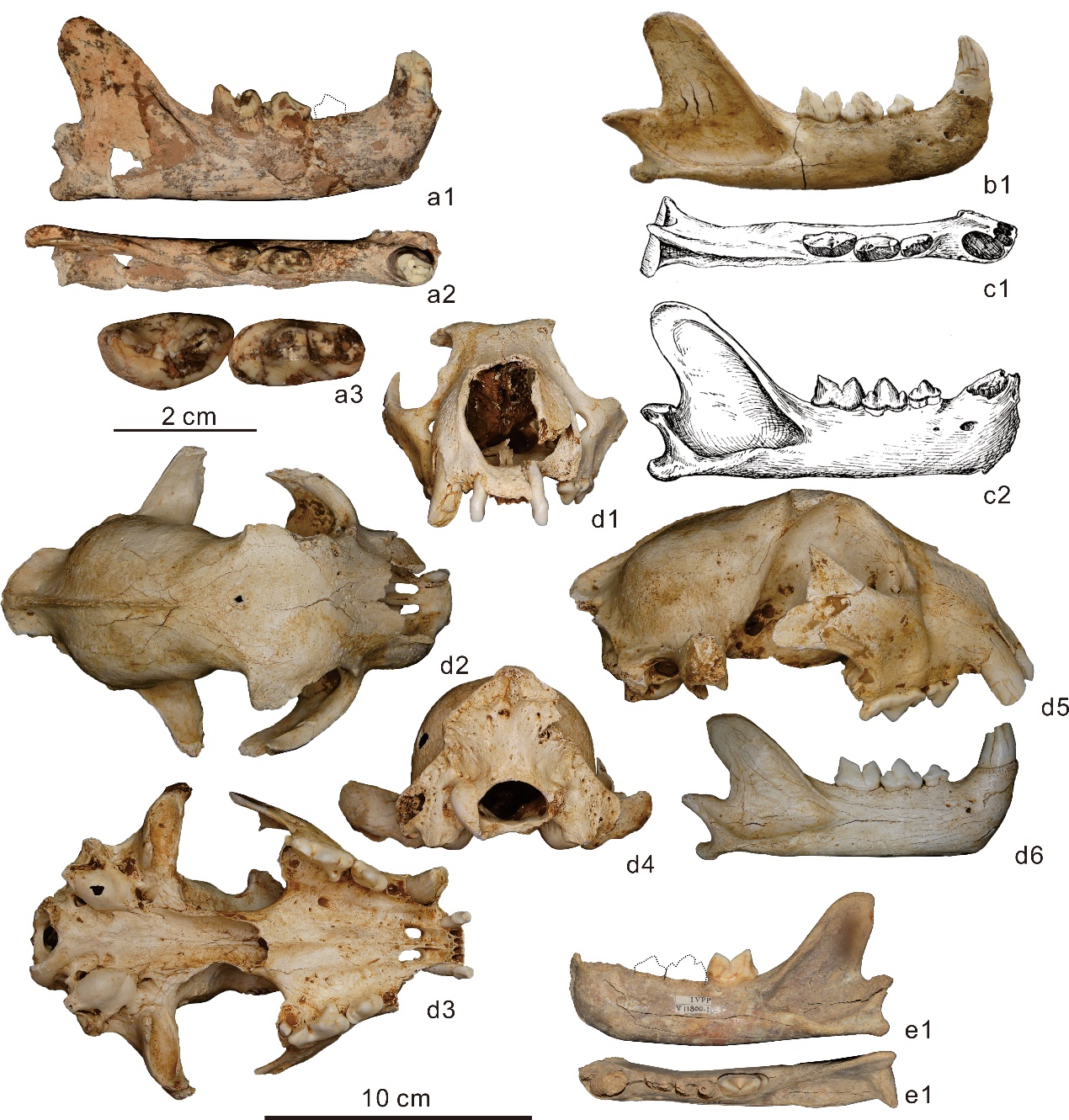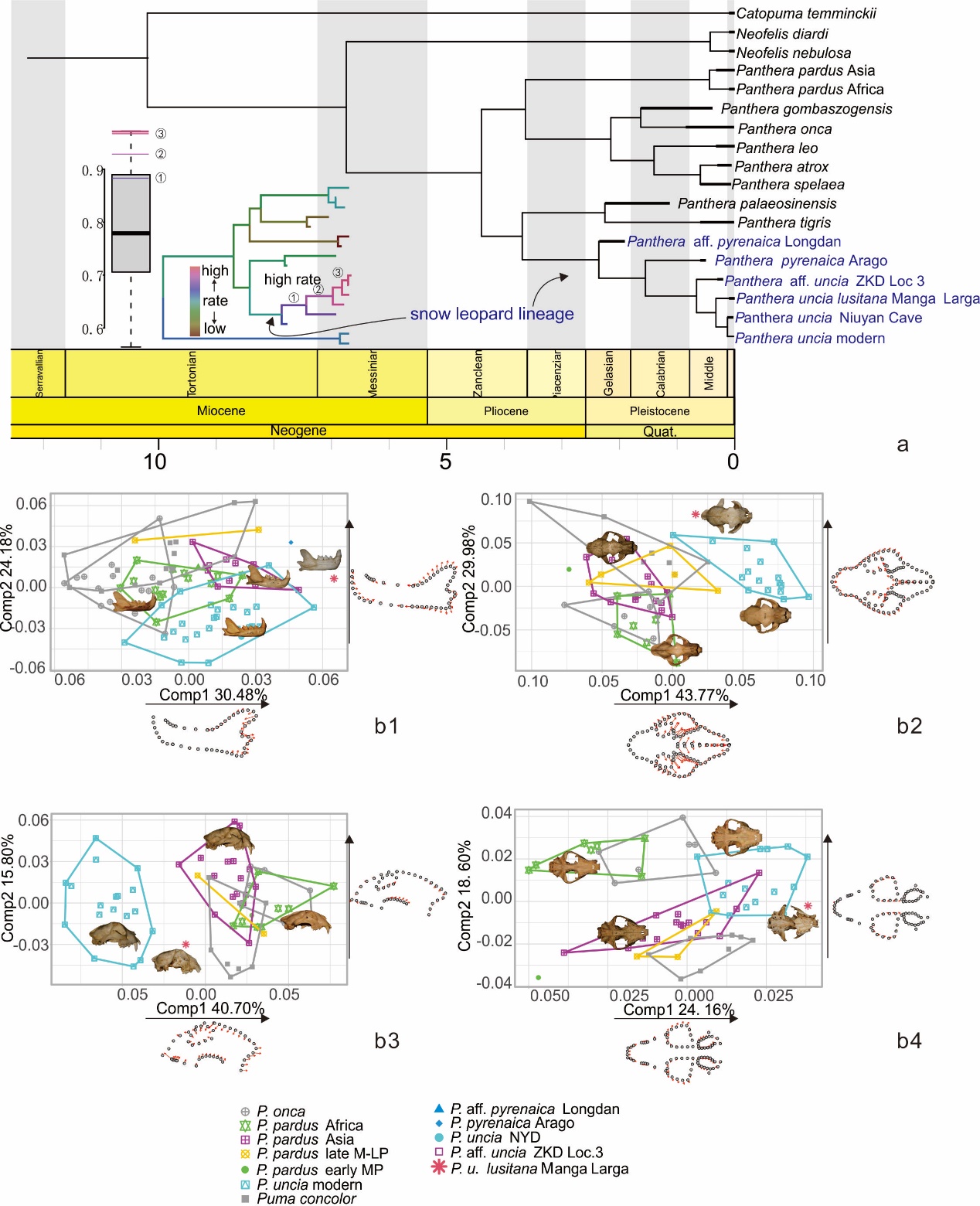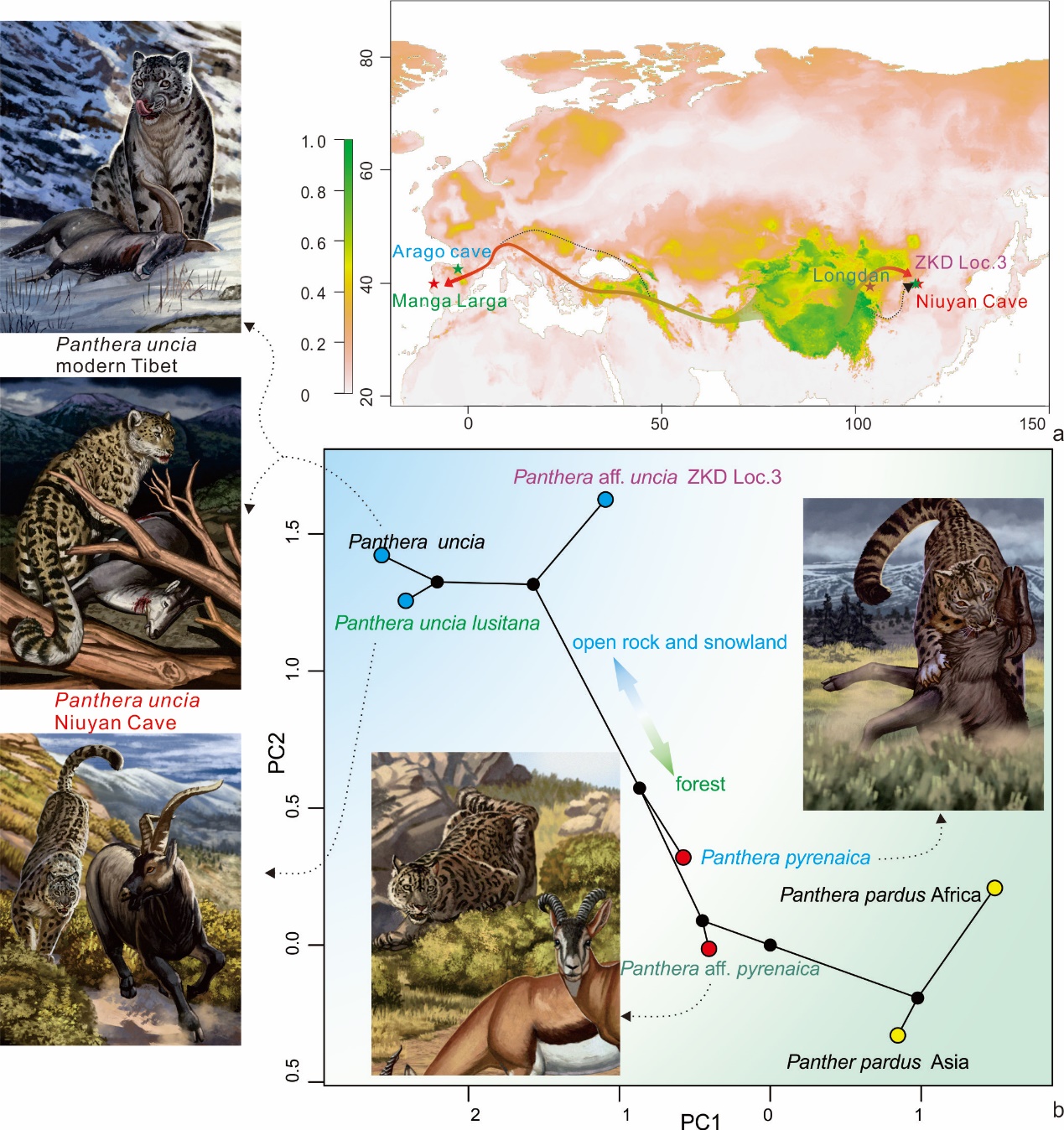Snow Leopard Fossils Clarify Evolutionary History of Species
The snow leopard (Panthera uncia) is a large feline unique to the Qinghai-Tibet Plateau and its surrounding areas. As the apex predator in the region, the snow leopard plays a crucial role in maintaining ecological stability. Its unique characteristics, coupled with its striking appearance, have made it a flagship species for conservation efforts aimed at protecting the ecosystem of the Qinghai-Tibet Plateau.
Unfortunately, few snow leopard fossils have been found in the Qinghai-Tibet Plateau region, particularly fossils from the Quaternary period. As a result, it’s unclear how snow leopards evolved their specialized adaptations to this environment.
On the one hand, molecular biology suggests that the snow leopard's closest living relative is the tiger. However, the morphological and ecological adaptations of snow leopards and tigers are vastly different. Therefore, molecular biology alone can’t explain how snow leopards developed their specialized traits.
Recently, an international research team identified rare snow leopard fossil records from various Panthera fossil sites across the Eurasian continent and used them to reveal the snow leopard’s unique evolutionary path. The study was authored by Associated Prof. JIANGZUO Qigao, from the Institute of Vertebrate Paleontology and Paleoanthropology (IVPP) of the Chinese Academy of Sciences (CAS), Associated Prof. LI Xinhai from the Institute of Zoology of CAS, and several researchers from Italy, Portugal, and France. Their work was published in Science Advances. Prof. DENG Tao and WANG Shiqi, from IVPP are co-corresponding authors.
The researchers were able to identify some of the fossil records as snow leopards by combining DNA sequences with morphological data, thus inferring the phylogeny of the Panthera genus. Their findings suggested that these records belonged to the snow leopard lineage, forming a paraphyletic group in relation to modern snow leopards.
The five valid Eurasian snow leopard fossil records identified by the researchers came from: Longdan in Gansu, China; Arago in France; Zhoukoudian Locality 3 in Beijing, China; Manga Larga in Portugal; and Niuyan Cave in Mentougou, Beijing, China. Except for the fossil from Niuyan Cave, which can be classified as a modern snow leopard, the others show significant differences compared to existing snow leopards.
The researchers concluded that the snow leopards found outside the Qinghai-Tibet Plateau are not an independent lineage but rather comprise small offshoots from the main snow leopard branch. It is likely that these offshoots represent multiple dispersals of snow leopards out of Tibet at different times. This approach allowed the researchers to study the gradual development of the unique specializations of snow leopards.
To study the evolution of important morphological features, the researchers then conducted a systematic analysis of the functional morphology of modern snow leopards using anatomy, geometric morphometrics, and finite element analysis. Their findings indicate that snow leopards have large eye sockets and highly developed binocular vision, suggesting they possess advanced stereoscopic vision that allows them to quickly focus on prey in complex terrain.
Snow leopards have a short snout and a steeply angled jaw, with canines that feature a nearly round cross-section. This structure enables them to exert powerful forces to subdue strong prey, although it may also compromise flexibility. Furthermore, snow leopards’ well-developed frontal sinus system warms inhaled air and enhances respiratory efficiency, making them animals well-adapted to cold, low-oxygen environments.
Moreover, snow leopards possess a pronounced tympanic bulla, which increases their sensitivity to infrasonic waves, allowing them to detect prey sounds from greater distances in open areas. Their large cheek teeth (i.e., premolars and molars) also enable them to consume most meat from prey before it freezes in the cold environment. In addition, these teeth improve snow leopards’ ability to chew already frozen carcasses.
While the scapulae and pelvis of snow leopards are relatively small, their distal limb bones are elongated. This indicates that their forelimbs have less muscular power but greater flexibility in movement, making them suited for running and jumping in mountainous regions. Most of these features represent adaptations to mountainous environments and to their primary prey, the Caprinae (sheep and related species), which tend to have slower speeds but short, robust limbs and strong horns for resistance. Only a small portion of snow leopard adaptations pertains to high-altitude, low-oxygen conditions.
The researchers studied the functional morphology of fossil snow leopards by correlating various morphological features with their functions. They discovered that early snow leopards, including the early Pleistocene Panthera aff. pyrenaica from Longdan and the early Middle Pleistocene Panthera pyrenaica from France, had mandibles that were already steeply angled but had not yet shortened. Additionally, their cheek teeth had not increased in size. This suggests an initial adaptation to Caprinae prey; however, no significant specializations for cold environments were apparent at this stage. Later fossils, such as the late Middle Pleistocene Panthera aff. uncia from Zhoukoudian Loc. 3 and the Late Pleistocene Panthera uncia lusitana, were found to be very similar to modern snow leopards, displaying comparable adaptations. However, certain features, including the development of the ectotympanic chamber and the extent of forehead expansion, were generally less pronounced in the European Panthera uncia lusitana compared to contemporary snow leopards.
Bayesian analyses of morphological evolution rates indicate that snow leopards began to change rapidly in the Middle Pleistocene. This timeframe coincides with the emergence of large ice sheets on the Qinghai-Tibet Plateau. Since the Middle Pleistocene, global climate variability has increased, resulting in more severe and prolonged glacial periods. These conditions allowed snow leopards to expand their range beyond the Qinghai-Tibet Plateau. Notably, the Middle Pleistocene also marks the period when many members of the Caprinae subfamily began to migrate from the Qinghai-Tibet Plateau into North China and Europe, paralleling the movement of snow leopards from the plateau.
To determine if fossil snow leopards had similar ecological adaptations to modern snow leopards, the researchers analyzed the relationship between the distribution of modern snow leopards and climate data. They employed a Random Forest approach, training a model known as Species Distribution Modeling to predict how snow leopards might adapt based on climate conditions. Subsequently, they applied climate data from the Last Glacial Maximum to evaluate the potential maximum distribution of modern snow leopards during that time period.
The results indicated that the potential suitable distribution for snow leopards during the Last Glacial Maximum was significantly larger than it is today. However, regions such as Europe and Beijing were outside the areas deemed suitable for their distribution. This suggests that fossil snow leopards may have developed ecological adaptations distinct from those of modern snow leopards. Consequently, the distribution of fossil snow leopards can’t be entirely predicted using modern snow leopard models.
Additionally, it is important to note that while these fossil sites are generally located at relatively low elevations (below 500 meters), they were situated in mountainous environments and typically contained Caprinae fossils. The only exception is the site in Portugal, which lacks faunal records. This observation suggests that mountainous terrain and the availability of related prey may have been more critical for snow leopards than the high-altitude, low-oxygen conditions.
The researchers also noted that Niuyan Cave is the only known site in the world containing both snow leopard and leopard fossils. Since we know that snow leopards today occasionally share habitats in transitional zones near the forest line, the Niuyan Cave discovery suggests that similar environmental conditions may have existed there when the fossils were deposited.
By integrating paleobiology, molecular biology, finite element analysis, and species distribution modeling, the researchers were able to trace the evolutionary history and functional morphological adaptations of the snow leopard, a key target of ecological conservation on the Qinghai-Tibet Plateau. Their findings reveal the evolutionary path of snow leopards, suggesting that mountainous terrain may have played a more critical role in their survival than climate factors alone. These insights are important to ongoing snow leopard conservation efforts and also prove the usefulness of preservation paleontology.
DOI: 10.1126/sciadv.adp5243

Fig. 1. Fossil snow leopards from Eurasia. a. Panthera aff.pyrenaica, IVPP V31895, Longdan, Linxia Basin, northeastern Tibet, China; b. Panthera pyrenaica, E14-EFNI-1001, Arago Cave, Southeastern France; c. Panthera aff. uncia, Zhoukoudian Loc. 3, Beijing, China; d. Panthera lusitana sp. nov., MG1355.0001-0002, Manga Larga, Portugal; e. Panthera uncia, IVPP V11800.1, Niuyan Cave, Beijing, China.

Fig. 2. Phylogenetic position and morphospace of modern and fossil snow leopards. a. Time-calibrated total evidence phylogenetic tree of pantherine cats, and the morphological evolutionary rate; b. geometric morphometric analyses on lateral views of the cranium and mandible of the fossil snow leopard in comparison with modern species, b1. mandible lateral profile; b2. cranial dorsal view; b3. cranial lateral view; b4. cranial ventral view.

Fig. 3. SDM predicted suitable distribution and morphospace of the modern and fossil snow leopards. a. The predicted probability of snow leopard presence under the LGM climate conditions; b. functional traits PCA morphospace, with reconstruction of fossil and modern snow leopards. Artwork by Jianhao Ye.
Download attachments: